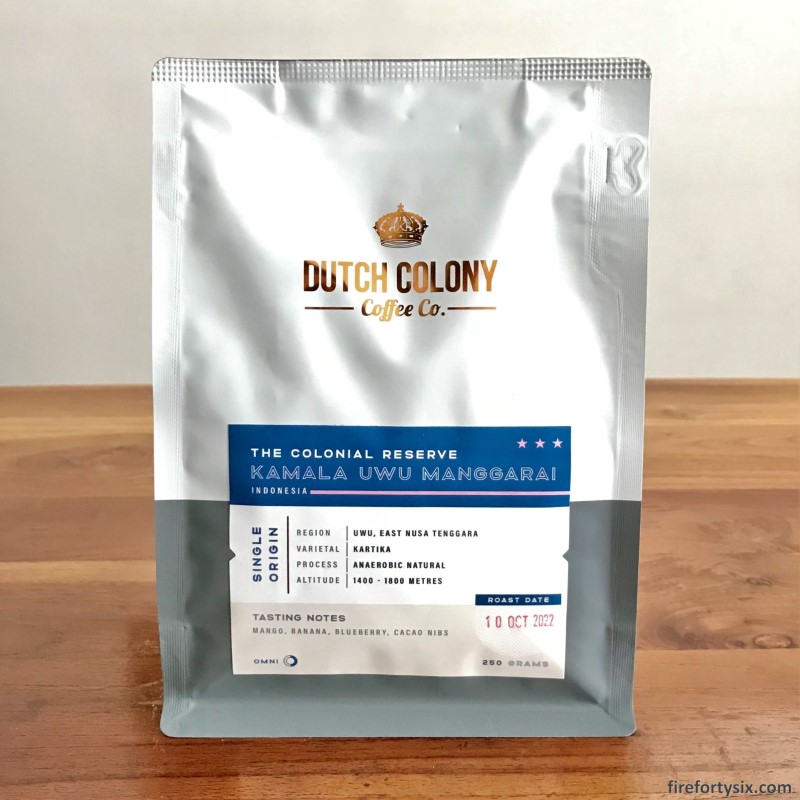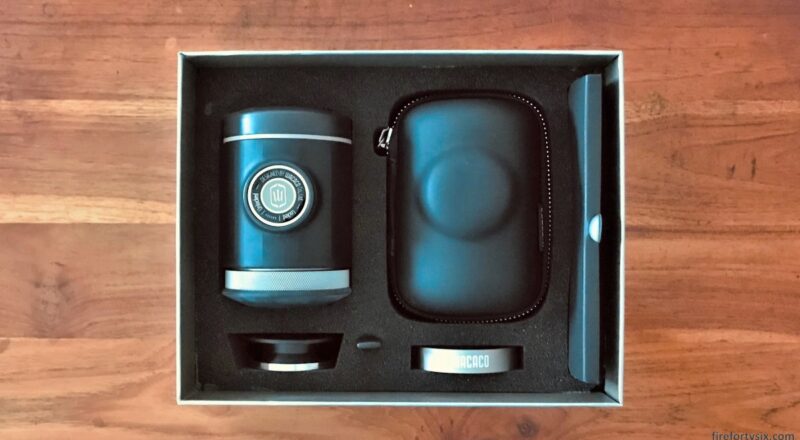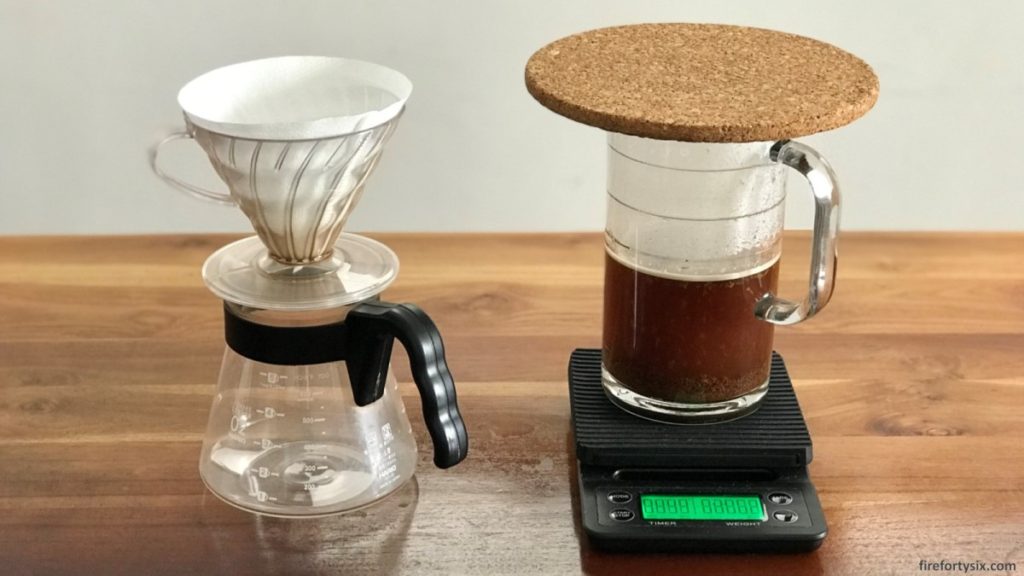19 months ago, I told myself to stop buying more coffee equipment. Since then, all my coffee-related purchases have only been consumables i.e. coffee beans, coffee capsules and V60 filter papers.
Six months into the moratorium, I was tempted to get the Clever Dripper, an immersion-style filter coffee device. It’s apparently super easy to use and supposedly makes consistent cups of good quality coffee.
But before I pulled the trigger, I wanted to test if we would actually like the different flavour profile compared to our usual V60 percolation approach.
Using existing equipment already in our kitchen, I jerry rigged a setup that would somewhat mimic the end results from a Clever Dripper. I then proceeded to make some test brews, using freshly-roasted Colombian and Panamanian beans.
It turned out we didn’t particularly enjoy the lighter flavour and body, and I decided to stick with my trusty Hario V60 for our daily morning caffeine fix. This also meant that I could keep my no-buy streak intact.
Fast forward a year later, and I began wondering if I should start getting serious about the espressos I was making. Well, technically I wasn’t the one making the espressos. It was fully automated and brewed by my Nespresso Creatista Plus.
I’ve owned a Nespresso machine of some shape or form for more than a decade. It used to be our daily driver some time back, before we switched over to pour over coffee. Even after that, I would still fire it up for an occasional afternoon latte.
While it can generate up to 19 bars of pressure, more than enough for the nine bars required for espresso, the coffee it produced wasn’t fantastic. Pleasant and drinkable, yes, but definitely not the quality of drinks in decent cafés.
I don’t think it’s due to the coffee itself, since we’ve moved on from the typically over-roasted Nespresso coffee. Nowadays, our capsules are from Jewel Coffee, a well-known local roaster, and we’ve tried every single type to find the one we prefer.
If anything, I think the main issue lies with the small dosage of each capsule, clocking in at a tiny 5 grams. Plus also the fact that the grounds aren’t tamped, which I’m assuming results in poorer extraction.
Yes, I could use more capsules for each cup that I make, which I actually do. But it just means that I get a larger volume of the same non-optimally extracted coffee.
Since espresso is not our primary caffeine delivery mechanism, buying an expensive home espresso machine won’t be cost effective. They can easily run into thousands of dollars, which seems excessive for what we need it for.
When my current Nespresso conks out, I’ll probably replace it with an entry-level proper espresso machine like the Breville Bambino Plus. It currently retails for around S$900 in Singapore, which is just slightly more expensive than the S$800 list price of the Creatista Plus.
But in the meantime, while the Creatista is happily humming along, I wanted to see if there were any cheaper alternatives that could bridge the gap. Something that would allow me to use a sufficiently large dose (18-20gm) of freshly-ground beans to make a proper espresso.
Since I already have the dependable 1Zpresso JX-Pro hand grinder for my pour overs, I can easily re-purpose it for espresso. Adjusting the grind is super easy and straightforward, especially with the well-marked settings and granular 12.5 micron steps.
That’s when the Wacaco Picopresso appeared on my radar, courtesy of the video review below by Josh from Alternative Brewing. He’s one of the few coffee YouTubers that I watch regularly, and I enjoy his easy going but no nonsense style when reviewing equipment.
After tasting coffee made using the Picopresso, he declared: “That’s good. That’s really good. Like espresso good.” And just like that, I was influenced, and S$180 poorer.
The Picopresso was designed for people who already have an espresso machine at home, but want to make an equally good cup when they’re out and about. Like when they’re camping in the wilderness, or slaving away in an office cubicle.
That didn’t exactly fit my profile, but it did meet my requirement for an interim cost-effective device that can make good espresso. But as much as I trust the wise words of Josh, I had to verify it for myself.

I had a few bags of beans in my coffee queue, and the next in line was the Kamala Uwu Manggarai from Indonesia. It was roasted by Dutch Colony Coffee, one of my trusted regular coffee suppliers.
Coincidentally, it was an Omni roast, suitable for making both filter coffee and espresso, making it an ideal guinea pig to test drive my new Picopresso. The coffee itself is quite interesting, and not something that I would typically get.
Firstly, it comes from Indonesia, an origin that I haven’t been able to brew good V60 coffee from. And secondly, it was processed using a modern anaerobic fermentation technique that I’m not familiar with. But the stated tasting notes of “mango, banana, blueberry and cacao nibs” were too interesting to ignore, and I bought it instead of my usual Ethiopian naturals.

There were a few things that I had to figure out during the experimentation process, and after several iterations, these were my optimal settings for one cup:
- Coffee dosage: 18gm coffee in, 36gm coffee out (250gm bag of beans = 14 cups)
- Grind size: 1-6-0 on the JX-Pro (within recommended range of 1-2-0 to 1-6-0 for espresso)
- Pump timing: 10 pumps before coffee first appears (10sec), wait to allow pre-infusion (30sec), another 22-24 pumps to reach 36gm out (30sec)
- Milk volume: 108gm per 36gm coffee, for 1:3 ratio (960gm carton of Meiji Red = 10 cups, factoring in weight increase after steaming)
It resulted in a complex and multi-layered latte that was rich, bright, fruity and chocolatey, all at the same time. Much much tastier than the ones I made with capsules. It was good. Really good. Like café quality good.
The workflow was quite convoluted though, given that I was making two cups. I had to pre-heat the Picopresso, then weigh, grind and tamp 18gm of coffee, then finally pump out the espresso.
After that, I had to let everything cool down sufficiently so that I could fish out the filter basket, knock out the used puck and then repeat the whole process. The body got quite hot the second time round, so I had to insulate it with a folded towel before I could hold it comfortably.
All in all, it took me a good 20 minutes to extract two cups of espresso. Thankfully, steaming the milk was super quick and easy with the Creatista Plus, and it took just another 2 minutes. I’m sure that it isn’t ideal to let espresso sit out for so long, but it is what it is.
For the quality of the final cups that I managed to make, I thought that the trouble was definitely worth it. But only because I wouldn’t be doing it on a daily basis, and will probably only make it during weekends.
And so it begins, this journey into the wonderful world of espresso…

